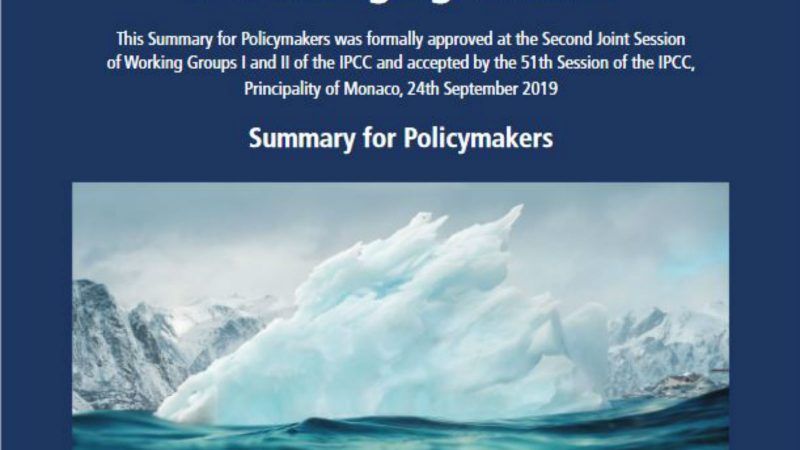Oceans Are Getting Hotter and Ice Sheets Are Melting Faster, Says New Report
Sea level rise is accelerating and marine heatwaves are becoming more common

The oceans are warming, becoming more acidic, and rising faster as a result of man-made climate change, according to a new special report, The Ocean and Cryosphere in a Changing Climate (SROCC). The report is a compilation of the latest research by climate scientists assembled under the auspices of the Intergovernmental Panel on Climate Change (IPCC). Its authors write that the extent of Arctic sea ice is steadily declining, mountain glaciers are melting, the area of snow cover on land is decreasing, and permafrost is warming.
As these trends advance, low-lying coastal areas will experience increased flooding, marine life will shift further polewards, coral bleaching events will become more common, weather patterns may shift in response to more open warmer water in the Arctic Ocean, and melting permafrost may exacerbate warming by gushing trapped carbon into the atmosphere.
Some of the topline findings in the SROCC are that "it is virtually certain that the global ocean has warmed unabated since 1970 and has taken up more than 90% of the excess heat in the climate system." In addition, it is likely that the rate of ocean warming has more than doubled since 1993. Researchers have very high confidence that marine heatwaves—defined as when the daily sea surface temperature exceeds the local 99th percentile over the period 1982 to 2016—have very likely doubled in frequency since 1982 and are increasing in intensity. It is virtually certain that by absorbing more carbon dioxide, the ocean has undergone increasing surface acidification.
Total global mean sea level rose by about 0.16 meters between 1902 and 2015 (a little over 6 inches). The rate of average sea level rise between 2006 and 2015 was about 3.6 millimeters per year, which is about 2.5 times the 1901–1990 rate of 1.4 millimeters per year. The rise in sea level is accelerating as water from melting ice sheets and mountain glaciers run into the oceans, and thermal expansion, as the oceans warm up.
In trying to see into the future, the SROCC chiefly focuses on two scenarios: one in which efforts to cut greenhouse gas emissions keep future global average warming to around 1.6 degrees Celsius by 2100, and another scenario in which no efforts to limit emissions results in an increase of 4.3 degrees Celsius by that same year.
Global mean sea level rise in the lower temperature 2100 scenario is projected to be about 0.43 meter (17 inches), with respect to 1986–2005. For the higher temperature scenario, the corresponding sea level rise is projected to be around 0.84 meter (33 inches) in 2100.
The rate of global mean sea level rise is projected to reach 15 millimeters per year by 2100 in the high temperature scenario, and to exceed several centimeters per year in the 22nd century. In the low temperature scenario, the rate is projected to reach 4 millimeters per year in 2100. While the researchers express low confidence in computer model projections for 2300, they note that sea level rise in the high temperature scenario could be as much as 2.3–5.4 meters (7 to 17 feet) and 0.6–1.07 meters (2 to 3.5 feet) in the low temperature scenario.
Interestingly, during the last interglacial period between 127,000 to 106,000 years ago, temperatures were between 1 and 2 degrees Celsius warmer than now and sea level was 4 to 6 meters (13 to 20 feet) higher. Researchers believe that the higher sea level of that time period occurred as a result of ice sheet melting in Greenland and Antarctica.
These trends certainly pose challenges to humanity. But there is good evidence that ingenuity and increasing wealth from economic growth can meet these challenges. Let's take sea level rise. As I noted in an earlier article:
Using a worst-case climate scenario in which no efforts were made to reduce future warming, a 2018 study in Earth's Future projected that sea level would rise by 2 and half feet by 2100. The researchers estimated that that increase would globally expand the area of land located in the 1-in-100 year coastal flood plain from its current area of about 210,000 square miles, to 290,000 square miles in 2100. The percent of the global population threatened by coastal flooding would rise (in the worst case scenario) from 3.6 percent now to about 5.4 percent by 2100.
A 2018 study in Global Environmental Change, this one also evaluating the economic effects of projected sea level increases ranging from 1 to 6 feet by 2100, concluded that it would be cost effective to invest in the protection of just 13 percent of the global coastline, thus safeguarding 90 percent the population and 96 percent of assets located in the global coastal floodplain. If these projections are approximately correct, addressing sea level rise will be costly, but it does not portend near-term societal collapse.
Setting aside big unexpected surprises, human ingenuity and increased wealth created by economic growth will similarly be able to adapt to the coming changes in the oceans and the cryosphere stemming from future climate change.



Show Comments (140)